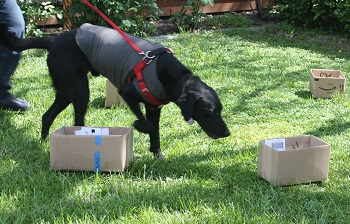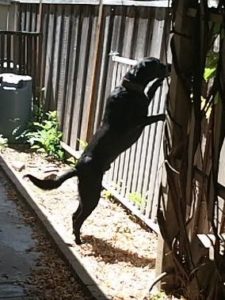Does your dog need a designated Nose Work harness?
May 26, 2015

You’ve signed up for Introduction to Nose Work, or another Nose Work class, and you’d like to know: Does your dog need a designated Nose Work harness? Is your dog better off if that special harness is a Nose Work cue?
It depends on who you ask.
Personally, I prefer equipment flexibility. My Labrador, Tigger, knows to go to work when he hears me say “Go search!” or he sees boxes or smells odor. One advantage is, I can pop out the odor box and set a search anywhere, any time, no matter what harnesses I happen to have with me at the moment. Plus, I like to try out different harnesses, so I have experience to share with my clients. That means Tigger has gone through a few different Nose Work harnesses. When no leash is required, he may even search naked. So, when I try out a new harness, or forget to bring his Nose Work harness with us, it doesn’t impact his focus or drive.

Some dogs, including some in advanced competitions, work on a simple straight collar, the same one they wear all day, and use for walks. This is the simplest way to go. No extra purchases, no extra stuff to carry around, no changing into the harness before practice.
On the other hand, the majority of people who pursue Nose Work use designated Nose Work equipment. When that equipment comes out, the dog knows what to expect. Dogs who are involved in more than one sport almost always have different gear for each different activity. It reduces confusion, and builds excitement as soon as the special items appear. It can help focus the dog, to know “These are my Nose Work clothes, so now it’s time to search and ignore everything else.” Service dogs are often trained this way, for instance, a guide-dog is trained to work when the special harness is on and to relax when it’s removed.
There’s an additional advantage to using a special Nose Work harness. Dogs are not allowed to soil the search area. You can teach your dog that when the leash is attached to the back of the Nose Work harness, it’s time to hold it in. I’ll bet your dog knows not to pee or poo inside your house; it’s a similar concept. You develop a routine: you attach the leash to the collar going to/from searches, and your dog may eliminate at will (or on command if you’ve trained it). Once you get to the search area, you switch the leash to the harness, and potty time is over for now.
There are several nice harnesses to choose from. Here are just a few.
Should you use a harness for Nose Work?
Benefits of using a harness:
- If there is tension on the leash during a search, that tension will not transfer to the dog’s neck, as it would with a collar
- Some dogs, particularly but not exclusively small dogs, have delicate a trachea, and should always have a leash attached to a harness instead of a collar
- Some dogs like the comfort of the harness; a close-fitting harness can feel almost like a mini ThunderShirt, which sometimes calms an anxious animal
Benefits of using a collar:
- Some dogs absolutely hate wearing anything but a collar (and maybe barely tolerate that)
- Body-sensitive breeds like sighthounds tend to be very distracted, perhaps even irritated, by anything that touches their bodies
- The collar will swivel around the dog’s neck, if the leash ends up on the wrong side of the dog; with a harness, handler intervention would be needed
- No need to buy more equipment (the harness)
Does your dog need a designated Nose Work harness?
In the end, it’s up to you. If it works for you and for your dog, you’ve made the right choice.
Do you have special clothing, equipment, or routines, that let your dog know “We’re going off to have a Nose Work adventure”? Do you use a harness, or a collar?
Copyright 2015 by Linda Fletcher
